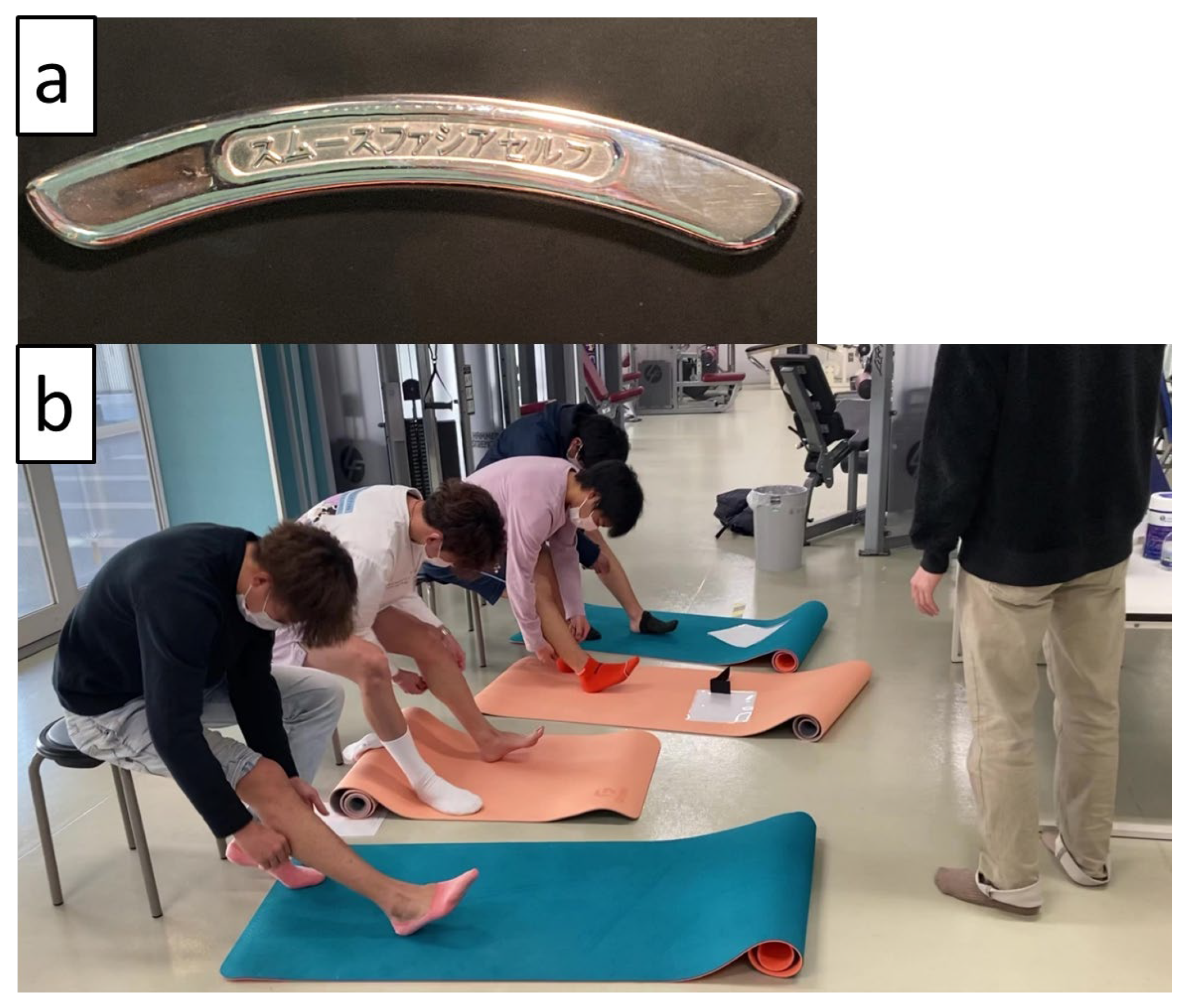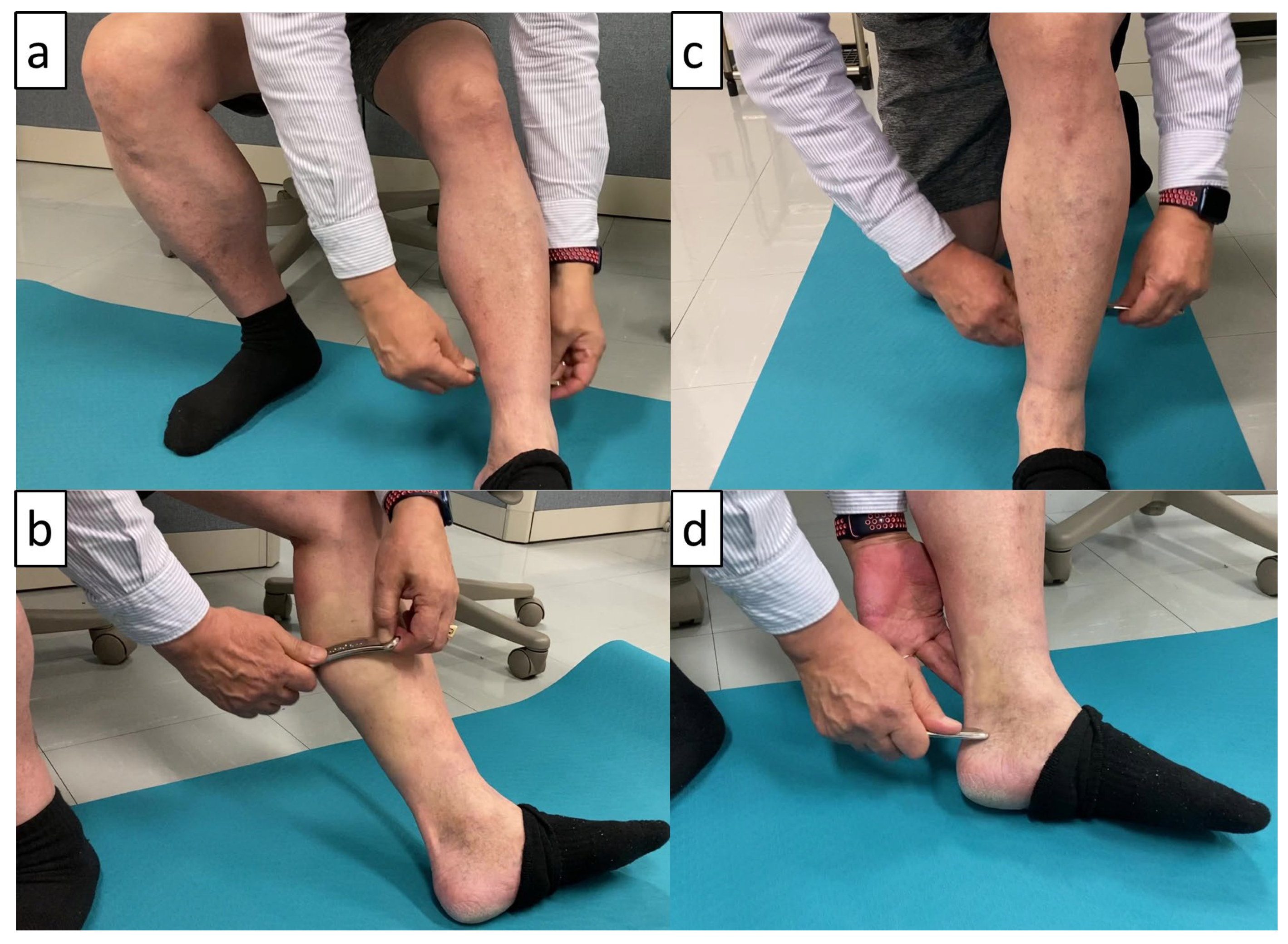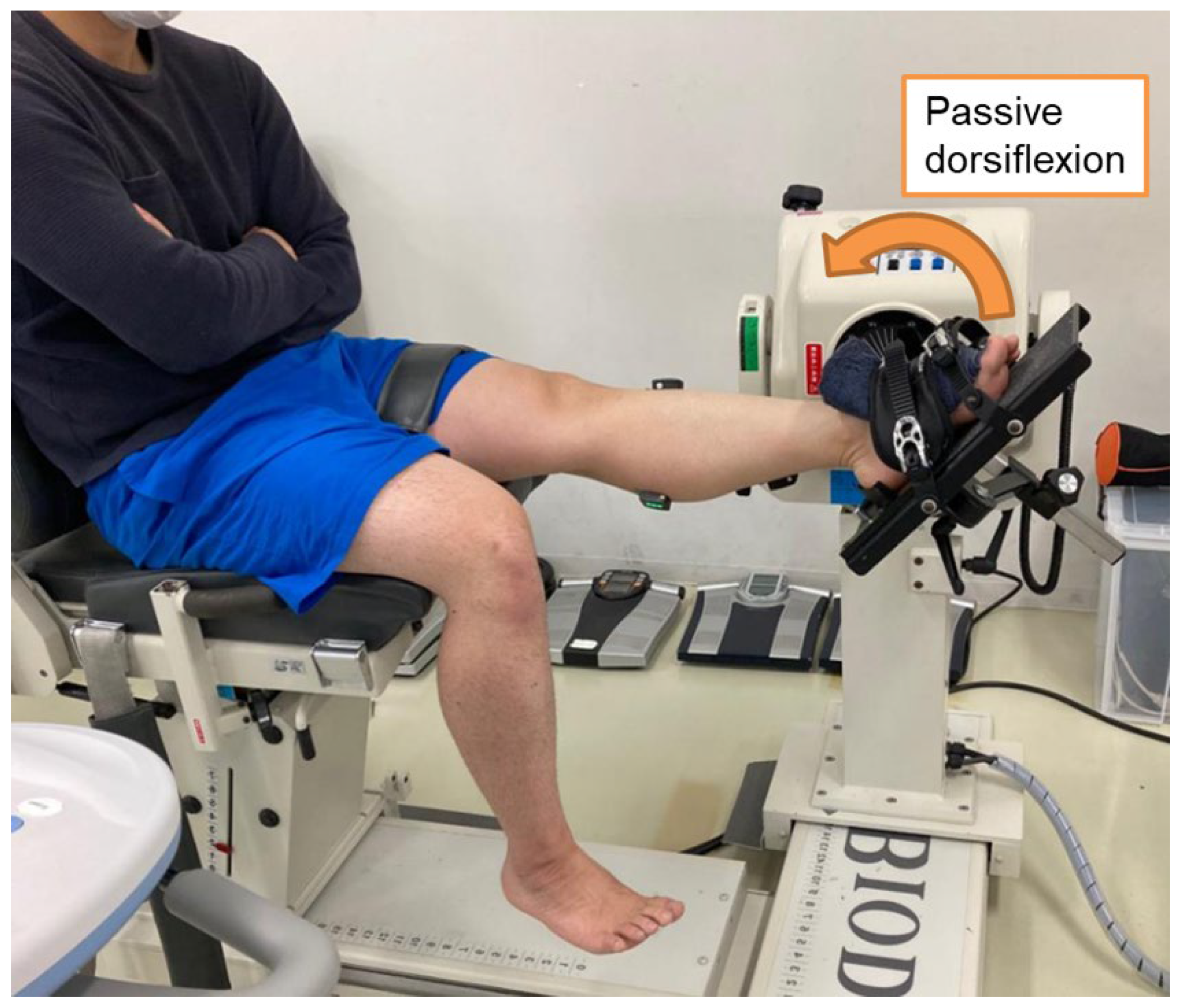Effect of 6-Week Instrument-Assisted Soft Tissue Mobilization on Joint Flexibility and Musculotendinous Properties
Abstract
:1. Introduction
2. Materials and Methods
2.1. Participants
2.2. Study Design
2.3. IASTM
2.4. Measurement of the DFROM
2.5. Measurement of Muscle and Tendon Stiffness
2.6. Statistical Analysis
3. Results
4. Discussion
5. Conclusions
Author Contributions
Funding
Institutional Review Board Statement
Informed Consent Statement
Data Availability Statement
Acknowledgments
Conflicts of Interest
References
- Stow, R. Instrument-assisted soft tissue mobilization. Int. J. Athl. Ther. Train. 2011, 16, 5–8. [Google Scholar] [CrossRef]
- Cheatham, S.W.; Lee, M.; Cain, M.; Baker, R. The efficacy of instrument assisted soft tissue mobilization: A systematic review. J. Can. Chiropr. Assoc. 2016, 60, 200–211. [Google Scholar]
- Kim, J.; Sung, D.J.; Lee, J. Therapeutic effectiveness of instrument-assisted soft tissue mobilization for soft tissue injury: Mechanisms and practical application. J. Exerc. Rehabil. 2017, 13, 12–22. [Google Scholar] [CrossRef] [PubMed]
- Nazari, G.; Bobos, P.; MacDermid, J.C.; Birmingham, T. The effectiveness of instrument-assisted soft tissue mobilization in athletes, participants without extremity or spinal conditions, and individuals with upper extremity, lower extremity, and spinal conditions: A systematic review. Arch. Phys. Med. Rehabil. 2019, 100, 1726–1751. [Google Scholar] [CrossRef] [PubMed]
- Laudner, K.; Compton, B.D.; McLoda, T.A.; Walters, C.M. Acute effects of instrument assisted soft tissue mobilization for improving posterior shoulder range of motion in collegiate baseball players. Int. J. Sports Phys. Ther. 2014, 9, 1–7. [Google Scholar]
- Markovic, G. Acute effects of instrument assisted soft tissue mobilization vs. foam rolling on knee and hip range of motion in soccer players. J. Bodyw. Mov. Ther. 2015, 19, 690–696. [Google Scholar] [CrossRef] [PubMed]
- Ikeda, N.; Otsuka, S.; Kawanishi, Y.; Kawakami, Y. Effects of instrument-assisted soft tissue mobilization on musculoskeletal properties. Med. Sci. Sports Exerc. 2019, 51, 2166–2172. [Google Scholar] [CrossRef]
- Palmer, T.G.; Wilson, D.B.; Kohn, M.; Miko, S. The effect of Graston massage therapy on talocrural joint range of motion. Int. J. Athl. Ther. Train. 2017, 22, 66–75. [Google Scholar] [CrossRef]
- Bush, H.M.; Stanek, J.M.; Wooldridge, J.D.; Stephens, S.L.; Barrack, J.S. Comparison of the Graston technique® with instrument-assisted soft tissue mobilization for increasing dorsiflexion range of motion. J. Sport. Rehabil. 2020, 30, 587–594. [Google Scholar] [CrossRef]
- Alter, M.J. Science of Flexibility, 3rd ed.; Human Kinetics Publishers: Champaign, IL, USA, 2004; pp. 1–71. [Google Scholar]
- Behm, D.G.; Blazevich, A.J.; Kay, A.D.; McHugh, M. Acute effects of muscle stretching on physical performance, range of motion, and injury incidence in healthy active individuals: A systematic review. Appl. Physiol. Nutr. Metab. 2016, 41, 1–11. [Google Scholar] [CrossRef]
- Magnusson, S.P.; Simonsen, E.B.; Aagaard, P.; Sørensen, H.; Kjaer, M. A mechanism for altered flexibility in human skeletal muscle. J. Physiol. 1996, 497, 291–298. [Google Scholar] [CrossRef] [PubMed]
- Lambert, M.; Hitchcock, R.; Lavallee, K.; Hayford, E.; Morazzini, R.; Wallace, A.; Conroy, D.; Cleland, J. The effects of instrument-assisted soft tissue mobilization compared to other interventions on pain and function: A systematic review. Phys. Ther. Rev. 2017, 22, 76–85. [Google Scholar] [CrossRef]
- Lee, J.H.; Lee, D.K.; Oh, J.S. The effect of Graston technique on the pain and range of motion in patients with chronic low back pain. J. Phys. Ther. Sci. 2016, 28, 1852–1855. [Google Scholar] [CrossRef] [PubMed]
- Ikeda, N.; Yonezu, T.; Kawakami, Y. Minute oscillation stretching: A novel modality for reducing musculo-tendinous stiffness and maintaining muscle strength. Scand. J. Med. Sci. Sports 2021, 31, 104–114. [Google Scholar] [CrossRef] [PubMed]
- Hug, F.; Lacourpaille, L.; Maïsetti, O.; Nordez, A. Slack length of gastrocnemius medialis and Achilles tendon occurs at different ankle angles. J. Biomech. 2013, 46, 2534–2538. [Google Scholar] [CrossRef] [PubMed]
- Morris, S.B.; DeShon, R.P. Combining effect size estimates in meta-analysis with repeated measures and independent-groups designs. Psychol. Methods 2002, 7, 105–125. [Google Scholar] [CrossRef] [PubMed]
- Cohen, J. Statistical Power Analysis for the Behavioral Sciences, 2nd ed.; Lawrence Erlbaum Associates: Hillsdale, MI, USA, 1988; pp. 19–74. [Google Scholar]
- Haff, G.; Triplett, N. Essentials of Strength Training and Conditioning, 4th ed.; Human Kinetics Publishers: Champaign, IL, USA, 2015; pp. 317–350. [Google Scholar]
- Gajdosik, R.L.; Allred, J.D.; Gabbert, H.L.; Sonsteng, B.A. A stretching program increases the dynamic passive length and passive resistive properties of the calf muscle-tendon unit of unconditioned younger women. Eur. J. Appl. Physiol. 2007, 99, 449–454. [Google Scholar] [CrossRef] [PubMed]
- Bohm, S.; Mersmann, F.; Arampatzis, A. Human tendon adaptation in response to mechanical loading: A systematic review and meta-analysis of exercise intervention studies on healthy adults. Sports Med. Open 2015, 1, 7. [Google Scholar] [CrossRef] [PubMed]
- Freitas, S.R.; Mendes, B.; Le Sant, G.; Andrade, R.J.; Nordez, A.; Milanovic, Z. Can chronic stretching change the muscle-tendon mechanical properties? A review. Scand. J. Med. Sci. Sports 2018, 28, 794–806. [Google Scholar] [CrossRef]
- Arampatzis, A.; Mersmann, F.; Bohm, S. Individualized muscle-tendon assessment and training. Front. Physiol. 2020, 11, 723. [Google Scholar] [CrossRef]
- Mahieu, N.N.; McNair, P.; De Muynck, M.D.; Stevens, V.; Blanckaert, I.; Smits, N.; Witvrouw, E. Effect of static and ballistic stretching on the muscle-tendon tissue properties. Med. Sci. Sports Exerc. 2007, 39, 494–501. [Google Scholar] [CrossRef] [PubMed]
- Konrad, A.; Tilp, M. Increased range of motion after static stretching is not due to changes in muscle and tendon structures. Clin. Biomech. 2014, 29, 636–642. [Google Scholar] [CrossRef] [PubMed]
- Simpson, C.L.; Kim, B.D.H.; Bourcet, M.R.; Jones, G.R.; Jakobi, J.M. Stretch training induces unequal adaptation in muscle fascicles and thickness in medial and lateral gastrocnemii. Scand. J. Med. Sci. Sports 2017, 27, 1597–1604. [Google Scholar] [CrossRef]
- Pacey, V.; Nicholson, L.L.; Adams, R.D.; Munn, J.; Munns, C.F. Generalized joint hypermobility and risk of lower limb joint injury during sport: A systematic review with meta-analysis. Am. J. Sports Med. 2010, 38, 1487–1497. [Google Scholar] [CrossRef] [PubMed]
- Kalkhoven, J.T.; Watsford, M.L. The relationship between mechanical stiffness and athletic performance markers in sub-elite footballers. J. Sports Sci. 2018, 36, 1022–1029. [Google Scholar] [CrossRef]
- Konrad, A.; Tilp, M.; Mehmeti, L.; Mahnič, N.; Seiberl, W.; Paternoster, F.K. The relationship between lower limb passive muscle and tendon compression stiffness and oxygen cost during running. J. Sports Sci. Med. 2023, 22, 28–35. [Google Scholar] [CrossRef]
- Nordin, M.; Frankel, V.H. Basic Biomechanics of the Musculoskeletal System, 4th ed.; Wolters Kluwer Health: Philadelphia, PA, USA, 2012; pp. 224–253. [Google Scholar]





| IASTM | Control | |||
|---|---|---|---|---|
| Pre | Post | Pre | Post | |
| Medial gastrocnemius shear modulus (kPa) | ||||
| 0° (neutral position) | 10.3 ± 3.3 | 8.7 ± 1.5 | 10.6 ± 3.0 | 9.7 ± 3.0 |
| DF 10° | 16.7 ± 4.4 | 15.8 ± 2.9 | 17.4 ± 6.7 | 15.9 ± 4.8 |
| DF 20° | 32.3 ± 8.5 | 29.4 ± 7.1 | 33.7 ± 8.8 | 30.6 ± 8.9 |
| Achilles tendon shear modulus (kPa) | ||||
| PF 20° | 78.4 ± 24.1 | 78.8 ± 27.4 | 81.5 ± 17.7 | 86.6 ± 24.5 |
Disclaimer/Publisher’s Note: The statements, opinions and data contained in all publications are solely those of the individual author(s) and contributor(s) and not of MDPI and/or the editor(s). MDPI and/or the editor(s) disclaim responsibility for any injury to people or property resulting from any ideas, methods, instructions or products referred to in the content. |
© 2024 by the authors. Licensee MDPI, Basel, Switzerland. This article is an open access article distributed under the terms and conditions of the Creative Commons Attribution (CC BY) license (https://creativecommons.org/licenses/by/4.0/).
Share and Cite
Ikeda, N.; Hiratsuka, K.; Isaka, T. Effect of 6-Week Instrument-Assisted Soft Tissue Mobilization on Joint Flexibility and Musculotendinous Properties. Sports 2024, 12, 150. https://doi.org/10.3390/sports12060150
Ikeda N, Hiratsuka K, Isaka T. Effect of 6-Week Instrument-Assisted Soft Tissue Mobilization on Joint Flexibility and Musculotendinous Properties. Sports. 2024; 12(6):150. https://doi.org/10.3390/sports12060150
Chicago/Turabian StyleIkeda, Naoki, Kazuya Hiratsuka, and Tadao Isaka. 2024. "Effect of 6-Week Instrument-Assisted Soft Tissue Mobilization on Joint Flexibility and Musculotendinous Properties" Sports 12, no. 6: 150. https://doi.org/10.3390/sports12060150
APA StyleIkeda, N., Hiratsuka, K., & Isaka, T. (2024). Effect of 6-Week Instrument-Assisted Soft Tissue Mobilization on Joint Flexibility and Musculotendinous Properties. Sports, 12(6), 150. https://doi.org/10.3390/sports12060150






